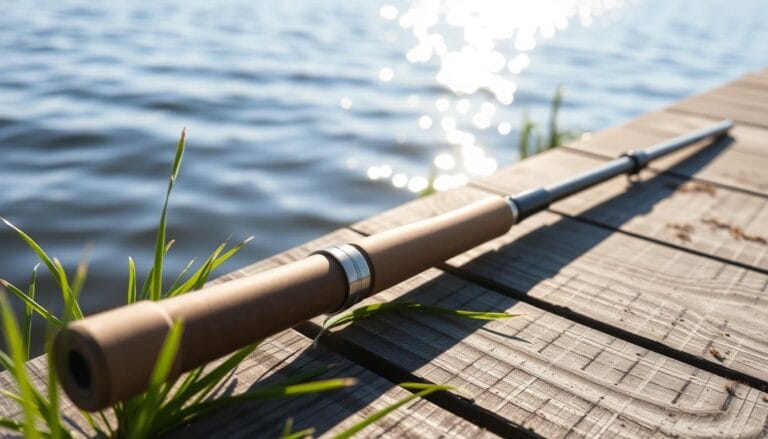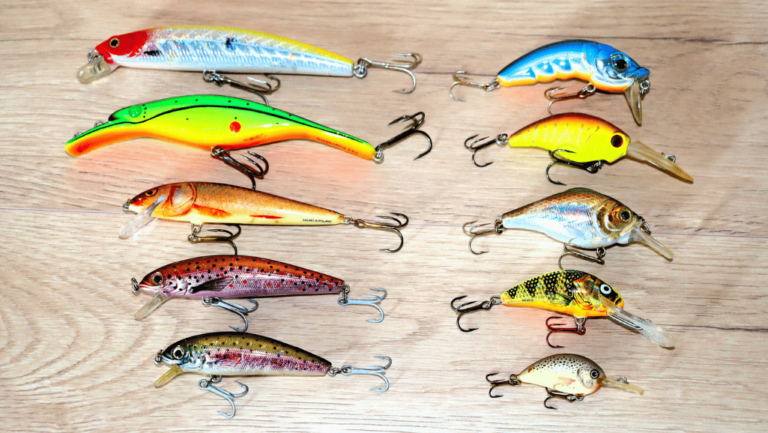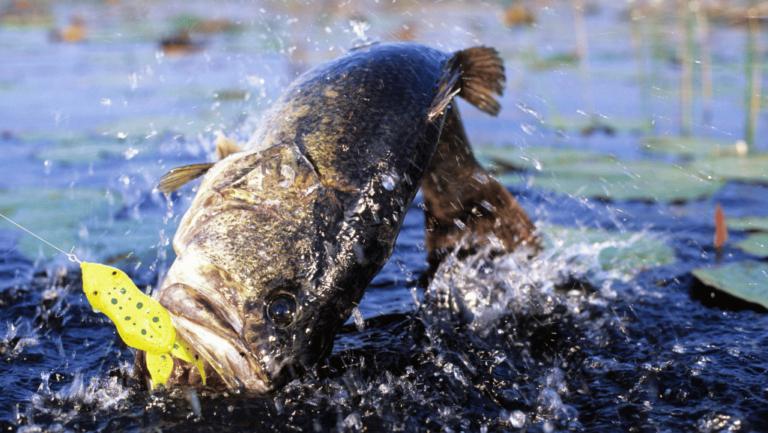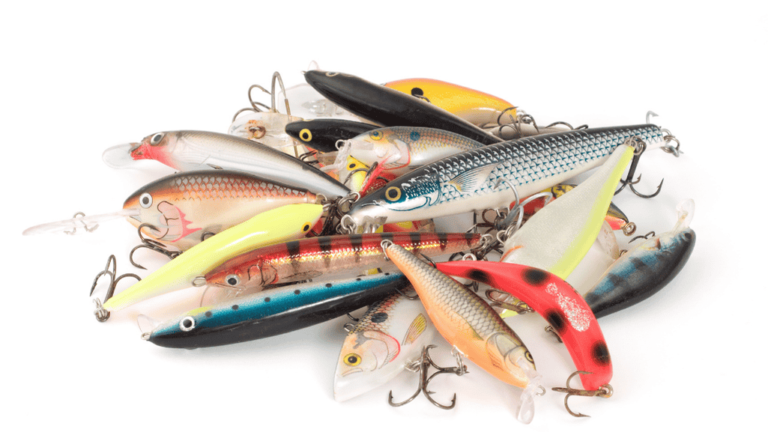Setting up a baitcaster right is key for better fishing. It’s important for beginners and pros to know how to set up a baitcaster. You need the right reel and to set the drag correctly for better casting. This guide will teach you all you need to know.
A good setup stops line tangles and problems like backlashes. We’ll show you how to use an arbor knot or a Uni knot to put your line on. You’ll also learn how to spool the reel without tangles. And how to set the spool tension and brakes for the right cast.
With this guide, you’ll get all the tips for a great baitcaster setup. By following our advice, your fishing time will be more productive and fun.
Key Takeaways
- Learn how to correctly attach the line using an arbor knot or Uni knot.
- Discover techniques for spooling the reel to avoid line tangles.
- Understand how to adjust spool tension and brake settings to prevent backlashes.
- Explore comprehensive steps on setting up and fine-tuning your baitcaster.
- Enhance your fishing efficiency and enjoyment with a proper setup.
Choosing the Right Baitcasting Reel
Choosing the best baitcasting reel is key to better fishing. The right reel improves your accuracy, comfort, and control. This leads to more success when you’re out fishing.
Why Reel Selection Matters
Picking the right baitcasting reel is important for all anglers. It offers the accuracy and ease both beginners and experts need. Knowing different reel types helps you cast and retrieve perfectly.
Top Brands to Consider
Brands like Shimano, Abu Garcia, and Daiwa stand out. They make reels for all fishing styles and skill levels.
Features to Look For
There are important features to check when shopping for baitcaster reels:
- Gear Ratio: It changes how fast and strong the reel is.
- Bearing Count: More bearings mean smoother performance.
- Frame Material: The material affects how strong and light the reel is.
- Brake Systems: They help control the spool and stop backlash.
Knowing these features helps find the right reel for you. This ensures you pick the best baitcasting set for your fishing needs.
Understanding Baitcaster Components
Knowing the key baitcaster components well is crucial for those wanting to boost their fishing game. Every part of a baitcaster reel has its job to improve how well it works. This makes your fishing more effective and enjoyable.
Baitcasting Reel Anatomy
A baitcaster reel is made up of several essential parts, each doing its own thing. Learning about these pieces helps a lot with putting the reel together and keeping it in good shape.
- Spool: Holds fishing line, important for how far and accurate you cast.
- Handle: It’s for reeling in the line. Comfort and control matter a lot here.
- Drag System: Changes how easy or hard it is for fish to pull the line out.
- Braking System: It controls the spool’s speed to stop tangles when you cast.
- Spool Tension Knob: You use this to adjust the spool’s speed. Perfect when using different sized lures.
All baitcaster components are crucial for making a reel work right. If you know how they work, your fishing gets better. It’s like learning secrets to catch more fish.
Key Parts of a Baitcaster
Getting the most from your baitcaster reel means understanding each part well. For example, you can adjust the drag system to set how hard it is for fish to pull your line out. This gives you more control when you’re fighting a fish.
For casting, the braking system helps stop the spool from going too fast. It’s great for newbies to prevent tangles. As you get better, you can use less braking. The spool tension knob lets you be really accurate with your casts by adjusting to push out your bait the right way.
| Component | Function | Adjustment Tips |
|---|---|---|
| Spool | Holds the fishing line | Ensure proper line tension |
| Handle | Retrieves the line | Choose ergonomic handles for comfort |
| Drag System | Regulates tension on the line | Adjust based on fish resistance |
| Braking System | Controls spool rotation during casting | Start with more brakes, then reduce |
| Spool Tension Knob | Fine-tunes spool speed | Adjust for different lure weights |
To truly enjoy fishing with a baitcaster, understanding each component is key. By mastering these parts and their settings, you can have a much better fishing trip. Your baitcaster reel will work like a dream.
How to Set Up Baitcaster
Setting up a baitcaster properly is key for smooth and accurate casting. You’ll find the spool tension knob, braking system, and drag on most baitcasting reels.
Mount the reel onto the rod tightly to avoid movement while casting. Then, thread the line through the rod guides and onto the spool. Make sure the line moves without any snags.
When setting the baitcaster reel, tighten all three controls first. It’s good to do this to prevent backlashes at the start.
The spool tension knob is small and round, much like a dime. Turn it until the bait drops slowly. This is how you set up the reel for your first cast.
Then, work on the braking system. It could be magnetic or centrifugal. For centrifugal brakes, adjust two pins together for better control. Magnetic brakes are easier to deal with because of their external dials.
Drag adjustment deals with the resistance on your line. It should be set according to the bait and fishing conditions. Normally, drag is loose and you might need to tighten it.
Always start with the brakes and spool knob fully tightened. Then, practice and adjust as you go. This will help you avoid backlashes and have a fun fishing trip.
| Component | Function | Adjustment Tips |
|---|---|---|
| Spool Tension Knob | Controls bait drop rate | Tighten fully at first, then adjust slowly |
| Braking System | Manages casting speed | Begin maxed out, then fine-tune |
| Drag | Regulates line resistance | Tighten gradually for optimal hookset and fight |
By following these tips, you’ll become a pro at setting up your baitcaster. This ensures your gear works just right for a great fishing adventure.
Spooling the Baitcasting Reel
Spooling the baitcasting reel right is key for smooth casting. It also cuts back on line twists and backlashes. Let’s dive into picking the best line and how to spool it up right.
Choosing the Right Line
Picking the right line for your baitcaster matters a lot. You need to think about the line type, weight, and where you’ll be fishing. Mono, fluorocarbon, and braided lines all have their pros and cons.
- Monofilament: It stretches and works well for new anglers.
- Fluorocarbon: Hard for fish to see and tough, great for clear water.
- Braid: Very strong and doesn’t stretch, ideal for lots of plants and far casts.
Knowing these differences helps you choose wisely. This betters your experience in all kinds of fishing situations.
Proper Spooling Technique
Spooling your baitcaster the right way makes sure the line is smooth. This fights backlashes and twists. To do it right, follow these steps:
- Thread the Line: Start by putting the line through the reel’s guide.
- Tie a Secure Knot: Tie the line to the spool using a strong knot.
- Apply Tension: Keep the line tight with your fingers as you spool.
- Even Distribution: As you spool, move the line back and forth to lay it even.
Getting this technique down boosts your casting and lowers line issues. Good spooling practices are vital for your fishing success.
Adjusting the Drag System
Getting the drag system right is key when you fish with a baitcasting reel. Knowing how to do this properly boosts your fishing game. This part will show you why the drag is important and how to set it just right.
What is Drag and Why It Matters
The drag system on your reel makes sure the line doesn’t break when a fish is fighting. It helps you wear out the fish without risking a line snap by spreading the tension well. Getting the drag right is crucial for a strong yet careful fishing style.
Steps to Adjust Drag
- Locate the Drag Star or Knob: You’ll find the drag adjustment near the reel handle. Turn it right to make the drag stronger and left to ease up.
- Set Initial Drag: Start at about one-third the line’s strength to avoid breakage. So, with a 15-pound line, go for 5 pounds of drag.
- Test the Drag: Pull the line by hand to check the resistance. It should come off easily but with some pull.
- Fine-Tune in the Field: Make small changes to fit the fish you’re after. This can really up your fishing game and care for your reel.
Keeping the drag system in tune makes your baitcasting reel work smoothly. With the right care, your reel will be ready for any fishing challenge. Enjoy a better time fishing by looking after your reel well.
Setting the Brakes
Knowing how to set the brakes on a baitcaster is key to cast control and avoiding tangles. A good handle on this makes fishing run smoother and easier.
Types of Braking Systems
Baitcasting reels have two main brake types, magnetic and centrifugal. Magnetic brakes work by using magnets to slow the spool. This is done by tweaking a side-mounted dial. In contrast, centrifugal brakes have small weights that push against the spool as it spins. Your choice between them depends on what feels best for you and where you fish.
How to Adjust Brakes
Getting your baitcaster’s brakes right involves matching them to the lure’s weight and wind speed. For magnetic brakes, adjust the dial until it’s just right. With centrifugal brakes, move the weights inside the reel to fit your needs. Finding the sweet spot in your baitcaster brake adjustment ensures you cast well and under control. Aim to start with stronger brakes and lessen them as you test, aiming for smooth, accurate casts. Remember, precise setup is a big part of baitcasting success.
| Brake Type | Adjustment Method | Ideal Conditions |
|---|---|---|
| Magnetic Brakes | Dial Adjustment | Variable Wind |
| Centrifugal Brakes | Weight Adjustment | Consistent Wind |
Fine-Tuning for Optimal Performance
Earning top-notch accuracy when casting with a baitcasting reel means paying close attention to details. This involves making precise adjustments. Key steps include setting the tension knob and fitting the reel to different bait.
Adjusting the Tension Knob
Getting the tension knob right is crucial for revving up baitcasting reels. This little tweak can hugely affect how far and accurate you cast. Here’s how to do it:
- First, turn the tension knob all the way tight.
- Then, slowly back it off until your bait falls smoothly, not causing any tangles.
- Lastly, fine-tune it depending on your lure’s weight and style.
This approach makes sure your tension knob is spot on, giving you more casting power and fewer troubles with tangles.
Calibrating for Specific Lures
Setting your reel right for each bait is key for hitting the bullseye when casting. Because every lure is different, tweaking is needed:
- Adjust the Tension Knob: Just like before, turn the tension knob according to the bait’s weight.
- Brake System Adjustment: Match your braking system to the lure’s weight and the wind’s force.
- Practice Casts: Try a few casts to fine-tune and fix any setting that’s off.
Following these steps ensures a smooth ride for anglers. With the right adjustments, every cast should meet your expectations for distance and accuracy.
| Adjustment | Steps | Benefits |
|---|---|---|
| Tension Knob Adjustment |
|
|
| Calibrating for Lures |
|
|
Maintenance and Care
Making sure your baitcasting reel gets the right care is key. This care helps it last longer and work better for every fishing season. Proper maintenance stops common issues and improves how your reel functions.
Cleaning Your Baitcaster
To keep your baitcasting reel in top shape, cleaning it well is important. Start by rinsing it with fresh water after fishing, especially in saltwater. Wipe it down with a soft cloth to get rid of dirt and salt.
Take your reel apart slowly and clean it with a mild detergent using a soft brush. Focus on cleaning the spool and gears well. This removes any dirt or debris that might cause problems.
Lubrication Tips
For your reel to work smoothly, it needs lubrication. Put a few drops of oil on the bearings, handle knobs, and spool shaft. Grease should be sparingly applied to the gears. This keeps them running well without getting too dirty. Lubricating your reel regularly helps it last longer.
Common Issues and Fixes
Knowing how to fix common problems can save you a lot of frustration. If your reel is oddly noisy, look for loose screws and check the lubrication.
- Tangled Line: To fix this, spool your line correctly and adjust your braking system to stop backlash.
- Gear Malfunctions: If your gears are slipping, worn, or clogged, clean and grease them as necessary.
Regular care and quick issue fixes keep your baitcasting reel as a reliable tool in your fishing adventures.
Common Mistakes to Avoid
Even skilled anglers can get frustrated with their baitcaster due to common mistakes.
It’s vital to know and dodge these errors for smooth casting and better fishing results.
One common mistake is not spooling the reel right. This can lead to line tangles. It also makes casting less efficient. Making sure the reel is spooled correctly can solve this. Incorrect brake system and tension knob settings are also a big issue. Proper adjustment for different baits and weather helps a lot.
- Skipping Regular Maintenance
- Incorrect Spooling Techniques
- Poor Brake and Tension Adjustments
- Ignoring Line Type and Weight Compatibility
- Inaccurate Drag System Calibration
Not keeping up with reel maintenance leads to more problems. Cleaning and putting oil on the reel stops gear troubles. It also helps the reel last longer. Knowing your reel and how it works lets you find and fix problems fast.
| Common Setup Mistakes | Potential Solutions |
|---|---|
| Improper Spooling | Evenly distribute line; ensure correct tension |
| Incorrect Brake Settings | Adjust brakes based on lure weight and conditions |
| Poor Tension Knob Adjustment | Calibrate tension knob for specific lures |
| Skipping Maintenance | Regularly clean and lubricate your reel |
| Inaccurate Drag Settings | Set drag system based on fishing conditions |
Learning about these mistakes and how to fix them makes fishing easier and more fun. Paying close attention to setup and looking after your gear well makes the baitcaster work its best. This leads to more fun and successful fishing.
Conclusion
Setting up a baitcaster is a key skill for anyone who loves fishing. We’ve shared all the steps to get your baitcaster ready. This covers choosing the best reel and adjusting the tension knob just right. Knowing how to handle parts like the tension knob, braking system, and drag helps you tweak settings perfectly.
Baitcasters are advanced tools, made for both right and left-handed users. They start with all settings off. You need to start from this point and slowly tweak each part. Learning about the brake systems, like magnetic or centrifugal, and how they manage spool speed is crucial for accurate casting.
The drag system, adjusted with a star-shaped piece, is also very important. Different fishing styles need different drag strengths. Bigger lines and single hook baits need a tighter drag. For baits with more hooks, a looser drag works better. Over time, testing and adjusting will make you a better angler. With the help of these baitcasting tips, you’ll dodge common errors and have fun mastering your baitcaster. Keep improving your skills, and fishing will become even more rewarding.









